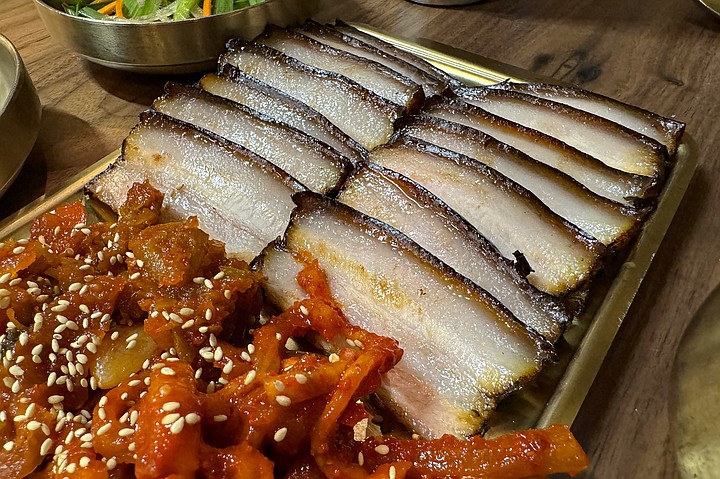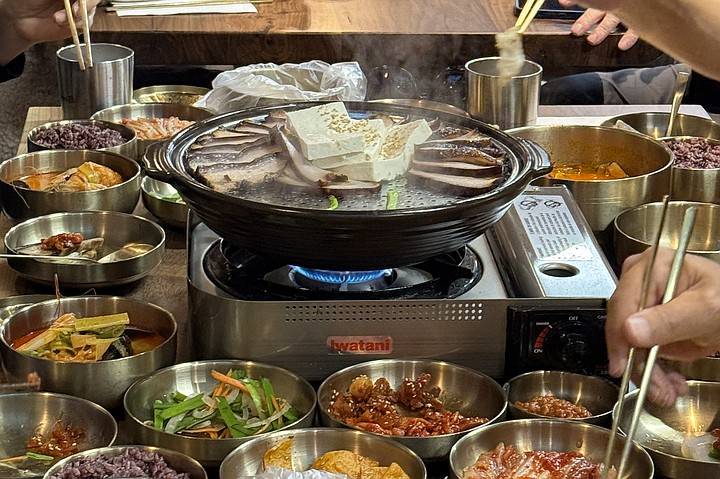 Facebook
Facebook
 X
X
 Instagram
Instagram
 TikTok
TikTok
 Youtube
Youtube

In San Diego, we’re not supposed to cheer on the arrival of cool, wet weather. But I straight up smiled when that first autumn storm rolled in last week, because I’ve been eager to warm up to the comfort food at Yuk Dae Jang.
That would be a popular South Korean restaurant chain that’s been steadily adding locations throughout Southern California the past five years, and this summer it finally landed a shop in the Convoy District. Better yet, it opened at 7307 Clairemont Mesa Boulevard, in one of the rare district shopping centers that provides plenty of parking. I’m particularly glad about that, because I’d like to return often. It only took one bite for me to understand why Yuk Dae Jang arrived with so much success behind it.
The name Yuk Dae Jung seems to be a play on its signature dish, yukgaejang ($18-25), which essentially translates as, “spicy meat stew.” Not stew as Americans tend to think of it; rather a noodle soup with a thick, red, spicy beef broth. Slippery glass noodles are the standard, but you may also order it with soft tofu, wheat noodles, or ramyun, the restaurant’s own handmade noodles (wider and flatter, with a bit more chew).

Being new to yukgaejang, I decided to start out with the glass noodles. What mattered more to me was trying the conventional protein: brisket. You can order a seafood version, but it’s always interesting to see how different cultures tackle brisket, which tastes incredible but takes hours of cooking to make tender. Here, the result is beef so shredded it’s long and skinny enough to get wrapped up around the noodles. There were moments when my metal chopsticks plucked strands from the bowl, and everything was so coated with sticky red broth that I couldn’t tell whether the next bite would be more noodle or brisket.
It didn’t matter. Turns out, that rich, sesame and spice stock is what makes yukgaejang tick. It’s the kind of soup (or stew) that warms you from the inside out. Comfort of the highest order, that happens to include a lot of of green onions.

But, there’s more to Yuk Dae Jang than yukgaejang, including better-known dishes such as bulgogi beef ($34), and seolleongtang ($17-19), a thinner beef and glass noodle soup made oxtail bone broth (which will be familiar to fans of nearby restaurant, Woomiok). But I had to try another new-to-me treat: bossam. From what I’ve read, it’s an autumn tradition in South Korea: slices of boiled pork belly that you wrap up in cabbage, with assorted fixings that include garlic chips, chili paste, and a fermented shrimp sauce.
You can definitely dine in parties of one or two, as I did. But it may be best to visit Yuk Dae Jang with a group, in order to share large orders of bossam and other dishes, ranging from hot pot ($60) to a large, braised beef rib served in a hot stone bowl ($77). Meanwhile, the smallest order of bossam goes for $22, while larger orders range up to $54. However, while my small bossam was served cold (which tasted fine), I noted that the next table had a large serving that featured both bossam and tofu, and a little tabletop grill to heat them up as you dine.

That looks pretty satisfying. Even with my small order, the process of building little pork belly cabbage wraps proved enjoyable: ingredients provided included jalapeños, chili paste, spicy daikon radish, and fermented plum. I probably didn’t need to wait for fall weather to embrace all of this, but at least I know how to cope if this winter proves as damp as the last one.


In San Diego, we’re not supposed to cheer on the arrival of cool, wet weather. But I straight up smiled when that first autumn storm rolled in last week, because I’ve been eager to warm up to the comfort food at Yuk Dae Jang.
That would be a popular South Korean restaurant chain that’s been steadily adding locations throughout Southern California the past five years, and this summer it finally landed a shop in the Convoy District. Better yet, it opened at 7307 Clairemont Mesa Boulevard, in one of the rare district shopping centers that provides plenty of parking. I’m particularly glad about that, because I’d like to return often. It only took one bite for me to understand why Yuk Dae Jang arrived with so much success behind it.
The name Yuk Dae Jung seems to be a play on its signature dish, yukgaejang ($18-25), which essentially translates as, “spicy meat stew.” Not stew as Americans tend to think of it; rather a noodle soup with a thick, red, spicy beef broth. Slippery glass noodles are the standard, but you may also order it with soft tofu, wheat noodles, or ramyun, the restaurant’s own handmade noodles (wider and flatter, with a bit more chew).

Being new to yukgaejang, I decided to start out with the glass noodles. What mattered more to me was trying the conventional protein: brisket. You can order a seafood version, but it’s always interesting to see how different cultures tackle brisket, which tastes incredible but takes hours of cooking to make tender. Here, the result is beef so shredded it’s long and skinny enough to get wrapped up around the noodles. There were moments when my metal chopsticks plucked strands from the bowl, and everything was so coated with sticky red broth that I couldn’t tell whether the next bite would be more noodle or brisket.
It didn’t matter. Turns out, that rich, sesame and spice stock is what makes yukgaejang tick. It’s the kind of soup (or stew) that warms you from the inside out. Comfort of the highest order, that happens to include a lot of of green onions.

But, there’s more to Yuk Dae Jang than yukgaejang, including better-known dishes such as bulgogi beef ($34), and seolleongtang ($17-19), a thinner beef and glass noodle soup made oxtail bone broth (which will be familiar to fans of nearby restaurant, Woomiok). But I had to try another new-to-me treat: bossam. From what I’ve read, it’s an autumn tradition in South Korea: slices of boiled pork belly that you wrap up in cabbage, with assorted fixings that include garlic chips, chili paste, and a fermented shrimp sauce.
You can definitely dine in parties of one or two, as I did. But it may be best to visit Yuk Dae Jang with a group, in order to share large orders of bossam and other dishes, ranging from hot pot ($60) to a large, braised beef rib served in a hot stone bowl ($77). Meanwhile, the smallest order of bossam goes for $22, while larger orders range up to $54. However, while my small bossam was served cold (which tasted fine), I noted that the next table had a large serving that featured both bossam and tofu, and a little tabletop grill to heat them up as you dine.

That looks pretty satisfying. Even with my small order, the process of building little pork belly cabbage wraps proved enjoyable: ingredients provided included jalapeños, chili paste, spicy daikon radish, and fermented plum. I probably didn’t need to wait for fall weather to embrace all of this, but at least I know how to cope if this winter proves as damp as the last one.